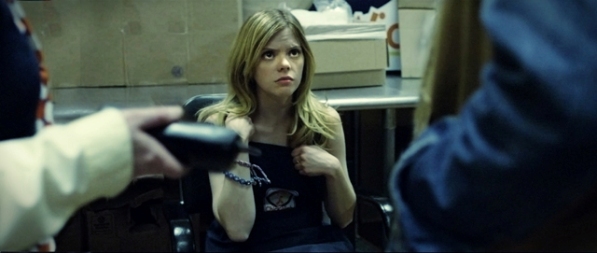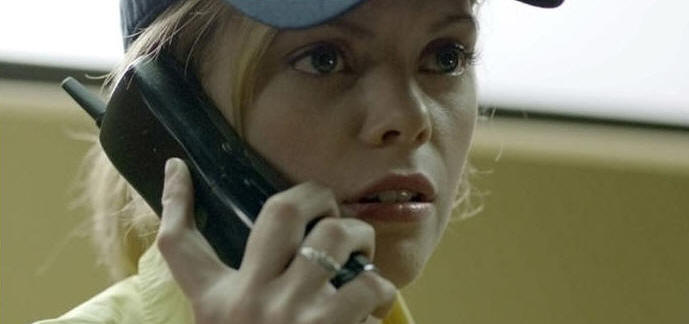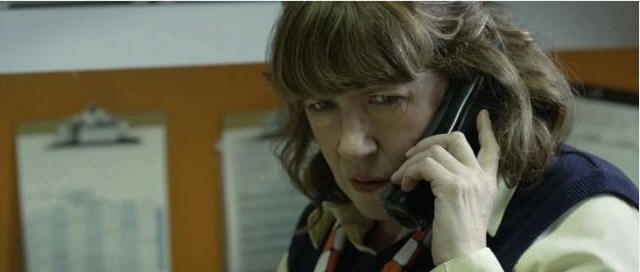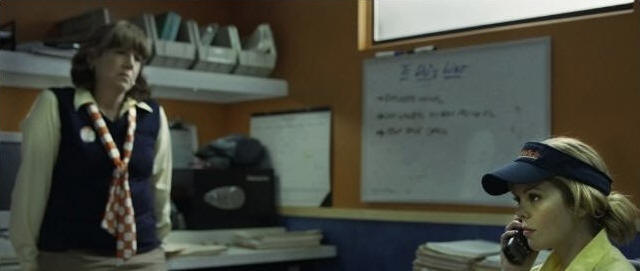MOVIE REVIEWS |
INTERVIEWS |
YOUTUBE |
NEWS
|
EDITORIALS | EVENTS |
AUDIO |
ESSAYS |
ARCHIVES |
CONTACT
|
PHOTOS |
COMING SOON|
EXAMINER.COM FILM ARTICLES
||HOME

Thursday, May 3, 2012
IN MOVIE THEATERS THIS SUMMER
Confronting Yourself On The Big Screen And Exiting The Theater For Relief: Why Audiences
Flee "Compliance"

Dreama Walker as Becky, the tortured center of the troubling, divisive and
excellent "Compliance".
Magnolia Pictures
by
Omar P.L. Moore/PopcornReel.com
 FOLLOW
FOLLOW
Thursday, May 3,
2012
They aren't fainting in the aisles or throwing up in the theater like
they did 40 years ago during "The Exorcist", or screaming with fright at "Alien"
just before the 1980s. These days, at film festivals in Park City, Austin,
San Francisco and elsewhere audiences are squirming and shifting in their seats, writhing and
gasping in shock and astonishment at the commands and incidents observed in
Craig Zobel's psychodrama "Compliance", a film that has alarmed, ruffled feathers,
offended sensibilities and deeply divided audiences.
"Compliance" is Mr. Zobel's second film (his first was "Great World Of Sound" in
2007.) Based on a true story at a McDonald's restaurant in Kentucky in
2004 (as well as built on at least 70 other incidents over a ten-year stretch
prior to that year), "Compliance" finds 19-year-old Becky (Dreama Walker), an
employee at the fictional ChickWich fast-food restaurant in Ohio accused by a voice over the
telephone -- a police officer (a great performance by a creepy Pat Healy) -- who says he has videotape evidence
that Becky has stolen money from a customer at the restaurant. Becky is adamant.
She's never stolen a thing in her life, she declares.
Becky's boss Sandra (Ann Dowd) is told by the voice -- an Officer Daniels -- that
she should search and detain Becky until the police arrive. She does.
From there things spiral disturbingly out of control. The audience is
held hostage to one cringing, nerve-wracking and horrific episode after another. No character
in the film calls the
police during Becky's ordeal even though a few declare that they won't do what
the voice on the phone tells them to.
Mr. Zobel's film uses the Milgram experiments of the 1960s as a distressing
theme. Those experiments were a series of electric shocks -- faked -- with
actors as victims pretending to be shocked -- after an administrator in another
room commanded a subject to increase the voltage on the victim if they answered
a question incorrectly. The shocks increased by 15-volts after each wrong
answer. When subjects grew skeptical of what they were doing to the
victims (many of whom claimed to have a heart condition), the administrator
would tell subjects to continue. Even after being told the shocks wouldn't
cause permanent damage despite "intense pain" --
subjects could hear the screams from an adjacent room -- the subjects continued the shocks at the behest of the
administrator, who stressed the importance of keeping the experiment going.
Shocks would routinely be increased in 15-volt increments from 15 volts all the
way up to 450 volts. Subjects were convinced that the victims were being
hurt. Sixty to
seventy percent of the time the subjects continued giving shocks to the victims
anyway. The subjects were everyday people, summoned to New Haven,
Connecticut as part of Yale professor Stanley Milgram's experiments.
Like the Milgram experiments "Compliance" highlights the grotesque things
ordinary people do in questionable or extraordinary circumstances, turning them
into instruments of monstrous, irrational behavior in spite of their better
angels. Sandra and her cohorts
know what they are doing to Becky is wrong but continue anyway, especially when told to
by a voice they consider an authority figure. The figurative alarm bell
named "why?"
occasionally rings out like a hypnotized but futile utterance, one spoken in
a trance-like way by several characters in response to Officer Daniels'
grotesque and unsettling requests.
"Why?" may be the only thread of resistance or opposition to the creepy phone
voice that these characters have left. "Why?" may be the only word that
prevents these human beings from becoming the very darkness or horror they seek
to escape. Becky, the film's most anguished victim, is compliant in
her own horrifying ordeal to an extent but with her exception "Compliance" shows
its players as both victims and criminals. The horrors that lurk within
these characters have always been there; it simply takes a shrewd, manipulative
agent like Officer Daniels or an off-guard, split-second to unearth them within
any one of us.
Us.
The audience that watches "Compliance" -- us -- is the biggest villain
of all.
One of the most popular responses -- by almost every audience member I spoke to
following the second S.F. Int'l Film Festival screening of "Compliance" -- was,
"I would never do something so stupid," or, "I couldn't believe how stupid those
people were." That common post-"Compliance" audience response may be a
visceral one but it may also be one uttered as a defense mechanism or a
distancing technique or as a buffer against their own very uncomfortable
reaction to what they have just seen. The hindsight, higher ground
response or "holier than thou" moral mountaintop declaration -- a way of
separating oneself from a film that forces the audience to participate in its
ghastly, invasive events particularly because of how it is constructed and shot
-- is the last line of defense for the audience, just as the word "why?" is the
last bastion for some of the characters in the film.

Dreama Walker as Becky,
an employee at the fictional fast-food restaurant ChickWich in "Compliance".
Magnolia Pictures
In both cases the line between the characters and the audience is inseparable
and the "why?" response and the "those people are so stupid!" response serve as
justified barriers or defense mechanisms against participating in bad behavior.
But do those responses do enough to rescue Becky?
That "Compliance" is inspired by or based on a true story is a horror unto itself but had it not been
the film would remain very convincing and plausible given aspects of everyday
human behavior familiar to all of us. We have all had moments of weakness
or lapses in judgment. We readily condemn these lapses in the political and
celebrity worlds. "Compliance" does not condemn them. The
film presents them without being sympathetic or indicting.
The audience watching "Compliance" however, is the most unforgiving of all.
So the overarching question is: why is it that a sizable number in any given
audience walk out on "Compliance" (which
opens in theaters in select U.S. cities on August 17)? Undoubtedly some
of the film's events are uncomfortable -- notably the matter-of-fact way it
shows
rational everyday people quickly and blindly assume authority simply because authority figures
confer it upon them or say that
it's okay to deputize oneself, even when those figures aren't physically present or even
seen. "You won't be responsible," Officer Daniels tells Sandra over the
phone in one scene. "I'll take the heat on this," he adds. Those spoken
lines illustrate a truism in human behavior: that if people think they can get
away with something that is bad, illegal or immoral, they will do that very
thing.
It is this real and disturbing everyday truth about human beings that "Compliance"
embraces and confronts head on, hurling it in the face of its presumably
escapist audience. In short, with "Compliance" and all of its economic,
class and generational tensions we
are shown something uncomfortable and inseparable from ourselves on the big
screen. There's no moralizing character in "Compliance" who jumps to
Becky's rescue in Act
Two-and-a-half or Act Three to say that what is happening to her is not only wrong
but criminal. No one hangs up the telephone and shuttles Becky, who has been stripped of her
clothes, out of the restaurant's backroom and safely home.
This is what the audience may well be most unsettled by, yet it might be safe to say
that some of those very audience members who exit the theater incensed and
troubled have in their own
daily lives observed things they knew were wrong yet failed to speak up or
affirmatively do something to prevent or address them. We've all been in
such situations.
So is it audience guilt, discomfort, something in their
own personal history or all of these that facilitate a hasty exit for some?
How many of us for example, have stayed quiet when a work colleague utters a
racist or sexist comment on the job, even though there are workplace handbooks
and state and federal laws in place specifically forbidding and not tolerating
such comments and behavior?
We escape the theater to seek refuge from a very uncomfortable truth about
ourselves. Some in the audience leave "Compliance" to escape from the
helplessness. Worse yet, the audience is miles ahead of the characters in
terms of what they know.
The only action for the audience is to either leave or stay.
There is an authentic psychological phenomenon called "diffusion of
responsibility", wherein people collectively rationalize a lack of urgency or
need to take responsibility for actions. Studies have shown that the lack
of accountability grows disturbingly as the group of people who observe a bad or
horrific act grows. The assumption is that someone else in the group will
take responsibility and do something. There's a "safety in numbers"
principle, or hiding place for people within a group as it gets larger. If
ten people witness a crime at work or on a street, the thinking is that there's
less of an incentive to be proactive to thwart it or take other action to bring
about its end, since
there's an implicit belief that someone else will. (It's like a fly ball in
baseball that two outfielders each think the other will catch but instead the
ball drops between them.)
When one is alone however, "diffusion of responsibility" says that people are
much more likely to act. (In the 1960s Darley and Latané established that
one's likelihood of action when responding to an emergency depended solely upon
how many were present. The likelihood of action grew with fewer people
around but diminished when more were present.)
Similarly, Darley and Latané found that when one person took action in a group,
others would be more likely to follow their lead, having been shown that it is
okay or safe to do so by the pioneering actor.

Ann Dowd as
Sandra, the manager of ChickWich restaurant in Craig Zobel's drama "Compliance".
Magnolia Pictures
Every day the human impulse to act or not act is tested.
How many of us have been shocked or literally frozen when hearing racist,
religious, sexist or other offensive jokes at work or from friends? (Do
you laugh with them, laugh uncomfortably or challenge them?) "Compliance"
covers that deep-freeze trance moment, extending it from an ephemeral twitch of
frailty, human ugliness or an unguarded second into a protracted, guilt-ridden 90
minutes.
There's an especially powerful cinematic moment where
cinematographer Adam Stone has close-ups of the eyes of several characters,
enhanced by Heather McIntosh's eerie, smart violin score. The quick,
succession of shots is a
moment of unspoken recognition of, checking in with, and an identification with the audience: we
all are capable of doing unthinkable and compliant things, especially when
trusted authority figures tell us it is okay to do so.
American tort law, administered by authoritative bodies, namely courts,
encourages and protects people from acting when seeing a stranger, in peril.
You can literally watch someone (a baby or one of any age) die before your very
eyes without having to save them, and not suffer criminal consequences as a
result of that failure. This is true even if you could save someone but
choose not to, because, say, you didn't want to get your clothes or new suit wet
by jumping into a water to save a drowning child's life. In most every
state in the United States, failure to act will not result in any criminal
charges in these specific examples.
Take, for example, the stabbing death of Kitty Genovese in Queens, New York in
1964. Ms. Genovese was literally killed in front of her neighbors on
estate grounds at night. Her death was seen by an estimated 70 people* who
watched from their windows. None of them shouted out to halt the
assailant's attack or telephoned the police, even as their neighbor screamed for her
life. They simply froze, watching like riveted, titillated, terrified spectators,
in much the way that automatic nagging curiosity within us compels us to slow down on a freeway
to look at
the sight of a nasty car accident. Is it that we want to see a body?
Blood? Is it that we can't look away because we want to see something awful?
Is that a subconscious desire in us as humans? The answer would have to be
yes.
The "Compliance" audience -- specifically those that walk out of the film are
wracked with guilt -- they could be akin to the same audience of spectators who
watched Kitty Genovese get stabbed to death. And how about those who
stay and watch the film? Even more so.
When some audience members walk out of "Compliance" it is their own form of
protest -- not necessarily against Mr. Zobel -- a nice guy who caught something
close to hell from some at the cold and snowy Sundance Film Festival after the
film's world premiere there in January. The protest is likely against his
anger-inducing characters, who seemingly know better and are actually more
intelligent than their undereducated trappings -- misspelled words like "employess"
are seen on a whiteboard in the restaurant's backroom --
might suggest.
It would be a grave mistake to say, as many who have seen the film so far have
said, that the people on the big
screen in "Compliance" are "stupid" people.
In real life people in large numbers initially supported
a war in Iraq that was clearly unjustified at the time, and in an absence of
weapons of mass destruction. Millions of Iraqis died as a result. In
reality, a large number of Americans believed Saddam Hussein was behind the
attacks on September 11, 2001, even when it was clear he was not, and even when
then-President George W. Bush said that "we have no evidence that Saddam Hussein
was behind the September the eleventh." And that was said after
the war in Iraq had begun.
How about the Orson Welles "War Of The Worlds" radio broadcast in 1938 which
prompted many people in America to believe that Martians had declared war and
were going to invade New Jersey?
It all appears silly in hindsight but the point is this:
We can all be fooled. We can all be gullible. At any given moment.
Stupidity has nothing really at all to do with it.
Even more scary: in World War Two many so-called "good Germans" stood by while
millions of innocent Jewish men, women and children were executed. U.S.
presidents held enslaved Africans in their homes and estates while talking about
freedom for America. Richard Nixon once talked of "the silent
majority", a majority that for this writer's money is often more homogenous, malleable
and terrifying than the brave few who challenge the status quo.
In reference to the real-life McDonalds' incident on which "Compliance" is
based, on one Internet message board someone says, "no law enforcement official
or police officer would ever ask someone to take all their clothes off!"
The poster of that comment obviously hadn't read these news stories (a,
b,
c) or seen this
video. The video of the actual events
"Compliance" depicts is far more disturbing than anything shown in the film.

Dreama Walker
as Becky (on phone), under the watchful eye of Sandra (Ann Dowd) in "Compliance".
Magnolia Pictures
With "Compliance" Mr. Zobel hits a nerve and approaches the line of chronicling
a spectacle of
victimhood but doesn't cross it. Mr. Zobel's camera does less to celebrate
victimhood or voyeurism than it does the perilous descent into groupthink and the
rational becoming the irrational in the chilling blink of an eye. People are
prodded on a psychological level in "Compliance" the way they were by Yale
professor Stanley Milgram. Mr. Zobel tries to get the audience to watch
the uglier aspects of human nature but doesn't exploit. Cameras move away
at key moments and audiences, faced with the horrors unspooling before them,
do so too.
The audience's only recourse -- in that sublime, plush-seated environment designed for escapist visions
-- is
to escape. To flee. In the film's initial screening at the San Francisco
International Film Festival last month
30 people walked out. In the
second and final screening of "Compliance" at the Festival, nine exited,
including a lady in her sixties sitting next to me who said, "I just can't watch any more of this."
"Compliance" is an instructive look at socio-psychology, and a breakdown in
common sense. The camera captures Sandra and other characters in
imbalanced framing, kooky Dutch angles and floating headspace as if tilted on a
very slowly-swinging pendulum. Sandra is ingratiated with and appraised by
Officer Daniels, who talks her up, charms her, wins her trust and encourages her in
ways that Stockholm Syndrome victims end up lauding their captors even after
they've been horrifically mistreated. Patty Hearst is one very famous
example.
Thus far "Compliance" is the year's best film, and whenever a film has the power
to shock, engage and move you in profound and smart ways without being
gratuitous it has done its job well. "Compliance" tests the audience's
own complicity in the film's events with its own reaction to them.
The dilemma becomes this: If
people walk out are they abandoning Becky? If they stay are they
symbolically complicit in the awful events Becky endures? As great art
"Compliance" is a Rorschach test. It's also a horror film without
bloodshed. All the horror is psychological, and very authentic. This
is what troubles audiences. There are no theatrical conceits or
recognizable movie devices that actively or sufficiently divorce the audience
from Becky's agony, which is hours and hours long (and was in real life),
condensed into about 40 minutes.
Sandra says that she is only doing what is right but is it because she really
believes it or because a police officer tells her to? By the time any
proper reflection on that specific question is entertained, it is far too late.
The wheels are already set in motion. Experiments have shown that the
reactions of Sandra and others in "Compliance" of non-action, peer response and
compulsion and such other practices, are common, very internal, part and parcel of the
human make-up and everyday response and inaction.
The good news is there are people who break free of this troubling inaction.
People on plane flights have stood up to defend themselves and others when a
passenger gets out of control. Others have saved lives. Anonymous
persons and famous ones (Ryan
Gosling, Tom Cruise for example) could have chosen to watch
as people died but instead they ended up saving lives.
Would they have felt less compelled to do so if part of a group of more than
three was with them? Studies tend to signal yes.
"Compliance" is an opportunity to watch human behavior -- and not so
much film character behavior -- up close and personal. There's no filter.
Nothing separates the audience from these characters and their decisions except
a screen and hindsight. These characters truly are us. We are
looking into a mirror when we see "Compliance", and what we see isn't pretty.
"Compliance" opens in select U.S. cities on August 17, and expands to
additional cities thereafter.

At Sundance 2012: Craig Zobel (left), the director of "Compliance", with actor
Pat Healy, who plays
Officer Daniels in the film.
Larry Busacca/Getty Images
*Note on Kitty Genovese:
several readers have rightly pointed out that indeed some neighbors had in fact
contacted police. Many writers at the time "sensationalized" the events
surrounding Ms. Genovese's murder. No one knows with certitude all of the
circumstances surrounding her murder. I have read accounts that said an
estimated 70 people saw her murder. Others have said 38. Some helped
but the few who did try turned out to help in vain, as police arrived quickly
but a little too late. The sad, bottom line in the Kitty Genovese case is
that no matter the number of people who were inactive while witnessing the
horrific events, a woman was raped and murdered.
COPYRIGHT 2012. POPCORNREEL.COM. ALL RIGHTS RESERVED.  FOLLOW
FOLLOW
MOVIE REVIEWS |
INTERVIEWS |
YOUTUBE |
NEWS
|
EDITORIALS | EVENTS |
AUDIO |
ESSAYS |
ARCHIVES |
CONTACT
| PHOTOS |
COMING SOON|
EXAMINER.COM FILM ARTICLES
||HOME

 FOLLOW
TWEET
FOLLOW
TWEET



 FOLLOW
FOLLOW